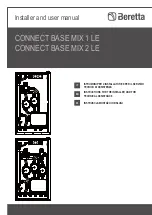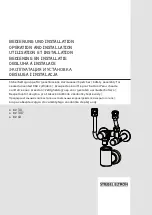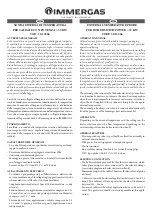
Benchmark 5000-6000 Boiler Installation & Startup Manual
SECTION 2:
INSTALLATION
OMM-0123_E
• GF-207 • 12/17/2019 Technical Support • (800) 526-0288 • Mon-Fri, 8 am - 5 pm EST Page
29
of
95
(b) If t
he valve fails with the Valve Stuck Closed fault, the “Valve Stuck Closed” message
will be displayed and the unit will shut down.
NOTE:
If the Valve Feedback option is used, Shorting Jumper MUST be inserted on JP2 on the I/O
Board (see Figure 2-14, above).
2.11.7 SHIELD (SHLD & SHLD)
The SHIELD terminals are used to terminate any shields used on sensor wires connected to the
unit. Shields must only be connected to these terminals.
2.11.8 ANALOG OUT
On current model Benchmark units, the default setting in the C-More Controller is Valve Position
0-10v, and behaves as follows:
•
0-10VDC
must
be selected for the voltage output used by the Controller to modulate the
combustion blower via the I/O Box terminals labeled
VFD/BLOWER
(Section 2.11.11).
•
If Boiler Sequencing Technology (BST) is enabled, the Analog Output terminals are used
to drive the isolation valve. A 0-20 mA signal is used: 20 mA = closed, 0 mA = open.
NOTE:
When driving an isolation valve, shorting jumper #JP2
MUST
be installed on the I/O Board.
On older legacy Benchmark units, the two ANALOG OUT terminals may be used to monitor
Setpoint, Outlet Temperature, Valve Position 4-20 mA, Valve Position 0-10v or be set to OFF.
2.11.9 RS485 Comm (+, GND, & -)
The three
RS-485
communication terminals are used when the boiler plant is being controlled
by an Energy Management System (EMS) or an AERCO Control System (ACS) using Modbus
(RS485) communication.
2.11.10 RS232 Comm (TxD & RxD)
As of Firmware version 4.0 and above, these terminals are used only by factory-trained
personnel to monitor onAER communications via a portable computer.
2.11.11 VFD/Blower (0-10 & AGND)
The two
VFD/BLOWER
terminals, 0-10 and AGND, send an analog signal to control the blower
speed.
2.11.12 Interlocks
The unit has two interlock circuits for interfacing with Energy Management Systems and
auxiliary equipment, such as pumps, louvers or other accessories. These interlocks are called
the Remote Interlock and Delayed Interlock (
REMOTE INTL’K IN
and
DELAYED INTL’K IN
in
Figure 2-14). Both interlocks, described below, are factory wired in the closed position using
jumpers.
















































